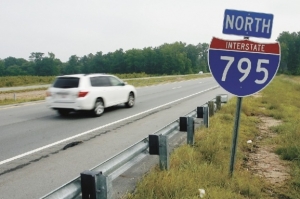Report: I-795 repairs will cost state $13 million
By Steve Herring
Published in News on July 17, 2009 1:46 PM

News-Argus/GREG SOUSA
An SUV drives along I-795 North Friday morning. Thursday state officials announced it will cost $13 million to repair crumbling pavement along the three-year-old interstate. The work is scheduled to be completed by the end of this year.
The state already facing a $4 billion budget shortfall will have to spend $13 million to repair Interstate 795. Department of Transportation officials have yet to determine how to pay for the project that is to be completed by year's end.
It has been less than three years since the 18-mile stretch of highway between Goldsboro and Wilson opened. Construction was completed in December 2005 and pavement damage began appearing by the summer of 2007.
The $13 million will be on top of more than $500,000 spent last fall to stabilize the worst sections of the roadway. The most severe cracking has been in the outside lanes and DOT officials had been concerned that winter weather would worsen the problem.
S.T. Wooten was the company that was responsible for the initial paving and subsequent repair work.
A DOT report released Thursday recommends replacing 1.5 inches of pavement on the outside lanes and overlaying the roadway with 3 inches of asphalt.
Calls to the Division 4 DOT office in Wilson earlier in the week were referred to the DOT public information office.
In an earlier interview, DOT division engineer Ricky Greene said that changes in the asphalt mix and design should ensure that the U.S. 70 Goldsboro Bypass under construction will not suffer the same problems as I-795.
DOT officials Thursday also released their final findings regarding the causes of the road's premature pavement damage. The findings come seven months after a Federal Highway Administration report released in January estimated the cost of repairs would be between $14 million to $22 million.
According to the federal study, the DOT "followed all appropriate procedures in the design of the pavement and that the failure was most likely due to deficiencies in the Hot Mix Asphalt."
The pavement crumbling might have been worsened by heavy, overweight truck traffic.
A February 2008 DOT study found that while the overall vehicle count on I-795 is about half what was assumed for design, the percentage of truck traffic is "significantly higher" -- 13.7 percent compared to 9 percent assumed in design.
According to that report a "significant portion (10 percent)" of the trucks were over the gross vehicle limit.
"The fact that this pavement began to exhibit signs of distress soon after the project was completed has been a matter of great concern," Jim Trogdon, DOT's chief operating officer, said Thursday. "Since this problem was first discovered, we have been working to determine its underlying cause, correct the issue and prevent it from happening again."
The DOT's conclusions attribute the problem to several contributing factors including marginal asphalt pavement thickness and the use of an "extremely dry" pavement mix that contained a low amount of the asphalt cement that binds the stone aggregate and other mineral material contained within the pavement mixture together.
Engineer Wendi Johnson had warned that the asphalt was not thick enough.
According to Thursday's report, the pavement's marginal thickness made it more susceptible to the damaging effects of traffic and that the low amount of binding cement material may have contributed to the poor performance of the pavement as well.
The findings mirrored the federal report that all work was conducted according to DOT specifications and policies.
However, the DOT added that changes need to be made to eliminate the potential for reoccurrence.
These include immediately making the transition to use of a "mechanistic" pavement analysis, which evaluates individual site and construction conditions, rather than relying on standard equations to determine the sufficiency of pavement materials.
The report indicates that employing such an approach to evaluating the asphalt mix used for I-795 would have predicted its early damage.
The DOT findings also recommend revising the process used to assess the strength and durability of asphalt mixes to make it more effective. It recommends eliminating the use of asphalt mixes with low amounts of binding materials unless extensive field performance history exists, as well as reviewing the selection criteria for several relatively new types of asphalt mixes and ensuring that engineers are familiar with the performance trade-offs for various mix types.
Originally designed as U.S. 117, the 18-mile four-lane divided highway between Goldsboro and Wilson was added to the Interstate System as I-795 in October 2007.
Reports and other documents regarding the department's findings are posted online at www.ncdot.org/newsroom.
